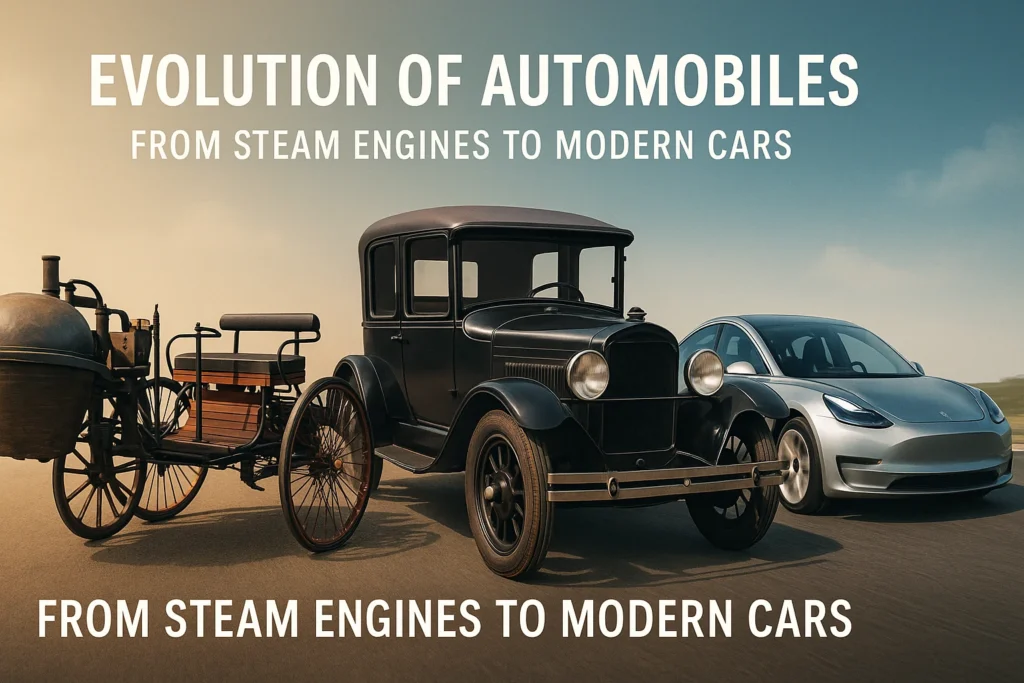
The automobile has transformed human civilization more than almost any other invention. From the first steam-powered vehicles of the 18th century to the electric and AI-driven cars of today, the automobile has continuously evolved to meet our needs for speed, safety, and sustainability.
In this article, we’ll explore the brief history and general introduction of automobiles, tracing their evolution from early experiments to modern innovations.
What Is an Automobile?
An automobile (or motor car) is a self-propelled vehicle used for transportation of people or goods. It typically runs on roads, has four wheels, and is powered by an internal combustion or electric engine.
Modern automobiles serve multiple purposes — from daily commuting to luxury and performance. They have become symbols of comfort, independence, and technological progress.
The Steam Age (1769–1885)
The first attempts at self-propelled vehicles began in the 18th century.
In 1769, Nicolas-Joseph Cugnot of France built the first steam-powered tricycle, designed to move heavy artillery.
Steam vehicles continued to develop through the 1800s, but they were bulky, slow, and difficult to control.
Despite these drawbacks, steam technology laid the foundation for modern automobiles.
The Birth of Internal Combustion Engines (1885–1910)
The true revolution came with the internal combustion engine (ICE).
In 1885, Karl Benz built the first gasoline-powered car — the Benz Patent-Motorwagen.
Around the same time, Gottlieb Daimler and Wilhelm Maybach developed high-speed petrol engines.
Henry Ford changed the game in 1908 by launching the Model T, the first mass-produced car, making automobiles affordable for everyone.
This era marked the birth of modern mobility.
The Rise of Mass Production (1910–1950)
The assembly line production system, pioneered by Henry Ford, transformed the automobile industry.
Cars became affordable, faster, and reliable.
Global manufacturers like Chevrolet, Chrysler, and General Motors grew rapidly.
Cars became symbols of freedom and modern living.
After World War II, automobile design focused on style, comfort, and performance, giving birth to the golden age of cars.
Technological Advancements (1950–2000)
The second half of the 20th century saw massive progress in car technology:
Introduction of power steering, automatic transmissions, and air conditioning.
Emission control systems were introduced to reduce pollution.
Diesel engines and compact cars became popular after the 1970s oil crisis.
The 1990s introduced computerized systems, making cars smarter and more efficient.
The Modern Era: Electric and Autonomous Vehicles (2000–Present)
The 21st century brought a technological revolution in automobiles:
Electric Vehicles (EVs) by Tesla, BYD, and Nissan dominate the market.
Hybrid vehicles combine electric and fuel power for better efficiency.
Self-driving cars use sensors and AI to navigate safely.
Modern cars now feature touch screens, voice assistants, and internet connectivity.
The focus today is on sustainability, automation, and zero-emission transportation.
Conclusion
From the first steam carriages to today’s smart EVs, the history of the automobile showcases human ingenuity and engineering brilliance.
Each era — steam, gasoline, electric — has contributed to shaping how we move, live, and experience the world. The automobile is not just a machine; it’s a symbol of progress that continues to evolve toward a greener, smarter future.
Key Takeaways
The automobile evolved from steam-powered prototypes to AI-driven EVs.
Karl Benz built the world’s first practical car in 1885.
Henry Ford’s Model T made cars accessible to common people.
Modern vehicles focus on sustainability, safety, and automation.
Frequently Asked Questions
1. Who invented the first automobile?
The first practical automobile was invented by Karl Benz in 1885. His Benz Patent-Motorwagen used a gasoline engine.
2. What was the first fuel used in cars?
Early vehicles used steam or gasoline. Gasoline became dominant after the success of Karl Benz’s design.
3. When did electric cars first appear?
Electric cars first appeared in the late 19th century, but regained popularity only in the 21st century with modern batteries.
4. What is the difference between hybrid and electric vehicles?
A hybrid vehicle uses both fuel and electricity, while an electric vehicle (EV) runs only on battery power.
5. What is the future of automobiles?
The future of automobiles lies in electric mobility, autonomous driving, and AI-powered smart vehicles focused on sustainability.





nice info
Thank you so for this lecture note. It has helped me prepare ahead for my coming class, test and exams. Still on it thanks again for this educative post.